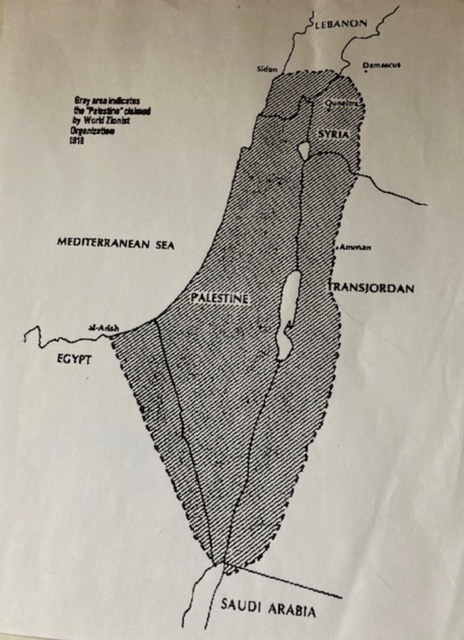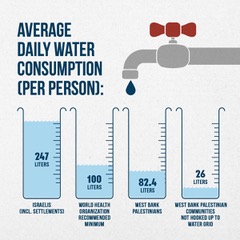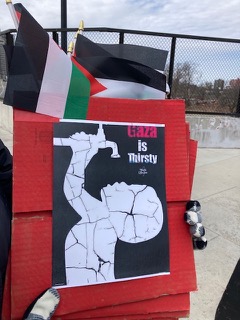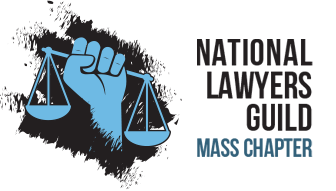Nancy Murray, Alliance for Water Justice in Palestine
Water is a human right – but Israel has made it a weapon
As Israel expands its genocidal war on Gaza, displaces more than 40,000 residents of West Bank refugee camps, and steadily empties the 62 percent of the West Bank called Area C under the Oslo process, the Palestinian cause has been put on life support.

But human rights defender Issa Amro from Hebron in the West Bank refuses to despair. Indeed, in his spirited talk with Peter Beinart at First Parish in Cambridge on April 8, the activist often referred to as the ‘Palestinian Gandhi’ outlined the major steps taken over the last few years to build international resistance to Israel’s occupation and system of Apartheid and argued that “there is a real hope that we can have a different future – but hope needs hard work.” He told the audience that the work of the international community has strengthened those Palestinians who have refused to leave their land despite intensified attacks by settlers and soldiers. What is urgently needed now, he said, is hope, creativity and the proliferation of concrete actions to support people on the ground and make the occupation more costly for Israel.
Here is a video of the event, which was organized by the Alliance for Water Justice in Palestine and co-sponsored by 18 groups, including the National Lawyers Guild – Massachusetts chapter.
Controlling the region’s water
Amro’s words about the need to support Palestinians as they resist by refusing to be driven off their land has a special resonance for the Alliance. Since our founding in 2013 to campaign against the water partnership that Gov. Deval Patrick had formed with the State of Israel, we have worked to raise consciousness about Israel’s discriminatory water policies which are intended to erase the Palestinian presence.

Well before the State of Israel was founded in 1948, water was a chief concern of the World Zionist Organization. In 1919, the Zionist Organization submitted a map showing the territory they wanted for their national home to the Paris Peace conference which was discussing how to re-draw the boundaries of the Middle East after the first World War. The map included areas with water resources needed to subsidize irrigation and what they called a ‘European style of life’ in their intended state. In the words of Chaim Weizmann, who would become Israel’s first president, “it is of vital importance not only to secure all water resources already feeding the country, but to control them at their source” – meaning the water that lay under all of Mandate Palestine including the aquifers of the West Bank, as well as the Golan Heights in Syria and southern Lebanon up to the Litani River, and all the land from the sea to well beyond the Jordan River.
After Israel was created in 1948, it set out to assert control over water. By the 1950s, it had water projects in the demilitarized zone at the foot of the Golan Heights. Between 1955 and 1964 it built the Israeli National Water Carrier Project – Mekorot – and began taking water from the Jordan River as well as the Golan Heights (where the headwaters of the Jordan River are located). Soon about a third of the original flow of the Jordan River was being diverted to Tel Aviv and Israel’s agricultural lands – depriving Lebanon, Syria and Palestinians of their rightful share. Well before the 1967 Six Day Israel was drawing water from both the Coastal aquifer which is the main aquifer for ground water in Israel and the Gaza Strip, as well as the Mountain aquifer, which is largely under the West Bank.
When Israel conquered the West Bank it immediately issued military orders monopolizing Israel’s control of water and prohibiting the Palestinians from digging wells. Since 1967 Palestinians have not been given a single permit to drill a new well in the Mountain aquifer, which should serve as their most plentiful water supply. The situation was not improved by the Oslo Accords. Oslo II in 1995 created a Joint Water Committee over which Israelis had an effective veto and specifically left the issue of water for a final agreement – one that has never been reached.
Barred from tapping into the water that is under the West Bank and even collecting rainwater, Palestinians have to buy their own water back at high prices from Mekorot. Not only that: the existing Palestinian water infrastructure (including cisterns, rooftop water tanks, and irrigation systems) has been repeatedly destroyed by Israeli soldiers and settlers. While Israeli settlers living in illegal settlements freely irrigate their land and fill swimming pools with West Bank water, Israel regularly cuts off the water supply to Palestinian towns, villages and refugee camps, especially in the summer months when water allocated to them is diverted to settlements. More than 700,000 settlers are allotted six times more water than three million West Bank Palestinians, whose access to water is well below the minimum standard set by the WHO.
The theft of water was one of the objectives of Isael’s 440-mile -long Apartheid wall, which cuts into the West Bank rather than following the Green Line, often to confiscate water resources. Over the years, settlers and soldiers have contaminated Palestinian wells, filled them with concrete, demolished irrigation reservoirs, and destroyed water tanks and pipelines. More than 80 Palestinian water wells in the West Bank have been destroyed since the latest war on Gaza began.
Many Palestinian families have been left with only two options: they can spend up to half of their monthly expenditure on trucked water or leave their villages and land altogether. The fact that so many families have chosen to stay on the land no matter the cost exemplifies Amro’s point: “existence is resistance.”
Weaponizing water in Gaza
If Israel has mobilized Water Apartheid policies in the attempt to drive Palestinians off their land in the West Bank, in the Gaza Strip it has made water a weapon in a genocidal war.
Pressure on the sole aquifer giving the Gaza Strip freshwater began in 1948 when its population tripled after more than 200,000 Palestinians were forced into Gaza from their homes in what became Israel. Five major Israeli military onslaughts since 2008 have repeatedly destroyed or damaged the water, sewage and electricity infrastructure. By 2020, with the population topping 2 million, 97% of the aquifer was unfit to drink due to high sewage and salinity levels, and the UN predicted that it would soon be irreversibly damaged.

Immediately after the Oct 7, 2023 Hamas attack, Israel prevented water, food, fuel, medicine and electricity from entering the Gaza Strip. Soon Gaza’s residents had to rely for drinking, cooking and hygiene on only three liters per day or less, with those crowded into UN shelters receiving only one liter (about 4 cups) per day. There were reports of people being forced to drink seawater and water extracted from polluted agricultural wells.
By mid 2024, over 70 % of all water and sanitation facilities in Gaza had been destroyed or damaged, and the amount of water available in Gaza per person was less than the water required for a single toilet flush. As untreated sewage flowed through tented encampments infectious diseases rapidly spread. Drinking polluted, heavily salinated water has dangerously weakened resistance to diseases like hepatitis and polio as dehydration and deliberately engineered famine took the lives of children. A study by the medical journal The Lancet predicted that the death toll in Gaza could exceed 186,000.
On March 2, 2025, rather than entering Phase II of the temporary ceasefire agreement, Israel again barred food, fuel, medicine, electricity and water from entering the Gaza Strip, and on March 18 it resumed its bombardments, including on Gaza’s sole functioning desalination plant. People are again on the verge of starvation. Today it is hard to imagine how the aquifer will recover from more than 80,000 tons of toxic explosives being dropped on an area half the size of Cape Cod. Israel’s war on Gaza, termed ‘plausibly genocidal’ by the World Court, is also a case study of ecocide.

Now Israel’s footprint in the region is beginning to approximate the 1919 map presented to the Paris Peace Conference. It has steadily emptied the Jordan Valley of Palestinians and established military bases in both southern Lebanon near the Litani River and the part of Syria that is rich in water resources. It appears dug in to stay.
In 2010 the UN General Assembly declared access to water to be a human right. If human rights and international law itself are to have any meaning, we must intensify our efforts to expand the international movement that brings hope to Issa Amro. We must join together to fight for an end to the genocide and a global politics that condemns Israeli Apartheid, promotes environmental justice, and embraces freedom, justice, and equality for all peoples in the region.



